December 2024
North America News
The U.S. Food and Drug Administration is issuing this letter to inform retailers and distributors of cookware that certain imported cookware products may leach lead (Pb) into food and that this cookware should not be distributed or sold in the U.S. market.
On 12 December 2024, the U.S. Food and Drug Administration (FDA) issued a warning letter to inform stakeholders that some imported cookware products made from aluminium, brass, and aluminium alloys known as Hindalium/Hindolium or Indalium/Indolium had the potential to leach lead when tested under conditions designed to simulate their use in contact with food. Information regarding this is outlined in an article provided to the FDA by the Public Health Department of Seattle and King County (PHSKC) in Washington State.
The article is published with the following key points:
Methods
The article said the PHSKC team screened aluminium cookware and brass items for lead content using an X-ray fluorescence (XRF) analyzer and used the leachate method[1]to estimate the amount of lead that migrates into food. They also tested additional stainless-steel items to determine whether they would be safer alternatives.
Results
Many aluminium cookware products contained above 100 ppm of lead. Many also leached enough lead under simulated cooking and storage conditions to exceed recommended dietary limits outlined by the FDA. In contrast, stainless steel cookware leached much lower levels of lead.
Impact
Aluminium and brass cookware available for purchase in the United States represents a previously unrecognized source of lead exposure.
Additionally, PHSKC posted a table on their website highlighting the cookware products demonstrating the most significant lead leaching, as revealed bytheir test results. The table includes pictures, brands, and country of origin, where available.
Currently, the FDA does not administer a lead standard for metal cookware, but the FDA has placed a manufacturer of the cookware, Rashko Baba Co. Ltd., on an FDA import alert to help prevent the further sale of these products in the U.S. market.
Retailers and distributors of cookware should be aware that there may be similar products that leach lead, including Rashko Baba products subject to FDA’s import alert, which remain on the U.S. market. Therefore, we suggest retailers and distributors of cookware products made from aluminium, brass, and aluminium alloys known as Hindalium/Hindolium or Indalium/Indolium take the necessary actions to confirm that such products do not leach lead into food. Various testing methods for leachable lead are available, or you may refer to the FDA’s lead leach testing protocol [1].
Remark:
[1] “Elemental Analysis Manual (EAM) Method 4.6 Inductively Coupled Plasma Optical Emission Spectrometric Determination of Cadmium and Lead Extracted from Ceramic Foodware” (https://www.fda.gov/media/95170/download). To modify for cookware, instead of a 24-hour extraction at 22 °C ± 2 °C, the extraction conditions include a 2-hour boil followed by cooling and holding at room temperature for a total of 24 hours. All other method details remain the same.The California Office of Environmental Health Hazard Assessment finalized changes to Proposition 65 Warning Regulations.
On 6 December 2024, the California Office of Environmental Health Hazard Assessment (OEHHA) published amendments to Proposition 65 Warning Regulations Title 27, California Code of Regulations sections 25601, 25603 and 25607.2 and added new sections 25607.50 to 25607.53 (Final Regulatory Text Updated 11-25-2024). The intention of the revisions is to make the warnings more informative and promote transparency to consumers.
The summary of the changes for consumer products is listed below:
| Section | New Version | Existing Version |
| Internet purchase (§ 25602) | A warning on the product display page, or A clearly marked hyperlink using the word “WARNING” or the words “CA WARNING” or “CALIFORNIA WARNING” on the product display page that links to the warning; An otherwise prominently displayed warning provided prior to purchase that the consumer does not have to search for in the general contents of the website | Products sold online have both a warning on the website as well as on the product itself |
| Short form warning (§ 25603) | Requirement that the short-form warning be in type size no smaller than the largest type size used for other consumer information has been removed The warning can be no smaller than 6-point type and must be conspicuous | Short-form warning type size shall not be smaller than the largest type size used for other consumer information |
| The word “WARNING:” or the words “CA WARNING:” or “CALIFORNIA WARNING:” in all capital letters and bold print | The word “WARNING” in all capital letters and bold print | |
| At least one chemical known to cause cancer or reproductive harm must be included Label with one of the following : (A) For exposures to listed carcinogens, the words: “Cancer risk from exposure to [name of chemical]. See www.P65Warnings.ca.gov.”; or “Can expose you to [name of chemical], a carcinogen. See www.P65Warnings.ca.gov.” (B) For exposures to listed reproductive toxicants, the words: “Risk of reproductive harm from exposure to [name of chemical]. See www.P65Warnings.ca.gov.”; or “Can expose you to [name of chemical], a reproductive toxicant. See www.P65Warnings.ca.gov.” (C) For exposures to both listed carcinogens and reproductive toxicants, the words: “Risk of cancer from exposure to [name of chemical] and reproductive harm from exposure to [name of chemical]. See www.P65Warnings.ca.gov.”; or “Can expose you to [name of chemical], a carcinogen, and [name of chemical], a reproductive toxicant. See www.P65Warnings.ca.gov.” (D) For exposures to a chemical that is listed as both a carcinogen and a reproductive toxicant, the words: “Risk of cancer and reproductive harm from exposure to [name of chemical]. See www.P65Warnings.ca.gov.”; or “Can expose you to [name of chemical], a carcinogen and reproductive toxicant. See www.P65Warnings.ca.gov.” | Do not need to specify name of chemical |
The new regulation is set to take effect on 1 January 2025. Businesses that use the current short-form warnings will have a 3-years transition period to implement the new short-form content. For internet listed products for purchase, a 60-day grace period allows for updates to online warnings upon receiving revised content from manufacturers. The products labelled with the existing short-form warnings before or during the transition period may continue to be sold without the need of relabeling.
The Canadian government published revised requirements for tents. The revised regulations, designated as SOR/2024-217, became effective upon publication within the Canadian Gazette on 20 November 2024.
(https://canadagazette.gc.ca/rp-pr/p2/2024/2024-11-20/html/sor-dors217-eng.html )
The original Canadian Tents Regulations became effective 21 January 1988 and were later reallocated under the Canadian Consumer Products Safety Act in 2011. These regulations included labeling requirements and flammability requirements for the floor, wall and top materials of tents. Minor changes have been made to the Tents Regulations since it was initiated. The Tent Regulations currently reference certain sections of the CPAI-84 (1995) Specification for Flame-Resistant Materials, with the most recent revisions in the Canada Gazette on 17 June 2023.
The new Tent Regulations, SOR/2024-217, published within the Canada Gazette on 20 November 2024, include a reference to CAN/CGSB-182.1-2020, Flammability and Labeling Requirements for Tents, along with other revisions.
The revisions include the following changes;
New definitions for (1) components and accessories, (2) safety standard, and (3) tents
Changes for (1) performance and testing requirements, (2) flooring materials, (3) labeling requirements, (4) children’s tents, (5) appliance clarification, and (6) a compliance period explanation for the revised regulation
Health Canada is also updating the Toy Regulations under the Canada Consumer Product Safety Act (CCPSA) by adding a flammability and labeling section specific for toys intended to be entered by a child, with reference to ISO 8124-2 (Safety of Toys-Part 2: Flammability). Health Canada is revising the Textile Flammability Regulations to exclude toys intended to be entered by a child as they will be now regulated under the Toys Regulations.
The revised regulation is effective as of the publication date within the Canada Gazette. However, a transitional provision was added. Product compliant to the previous regulations can continue to be manufactured, imported, advertised and sold for two years from the effective date.
In the US, when hazards are identified in consumer products, they will be recalled and published in the Consumer Product Safety Commission (CPSC) Recent Recalls on the CPSC website, which is updated daily. The US recalls from 01 November 2024 to 30 November 2024 are summarized below:
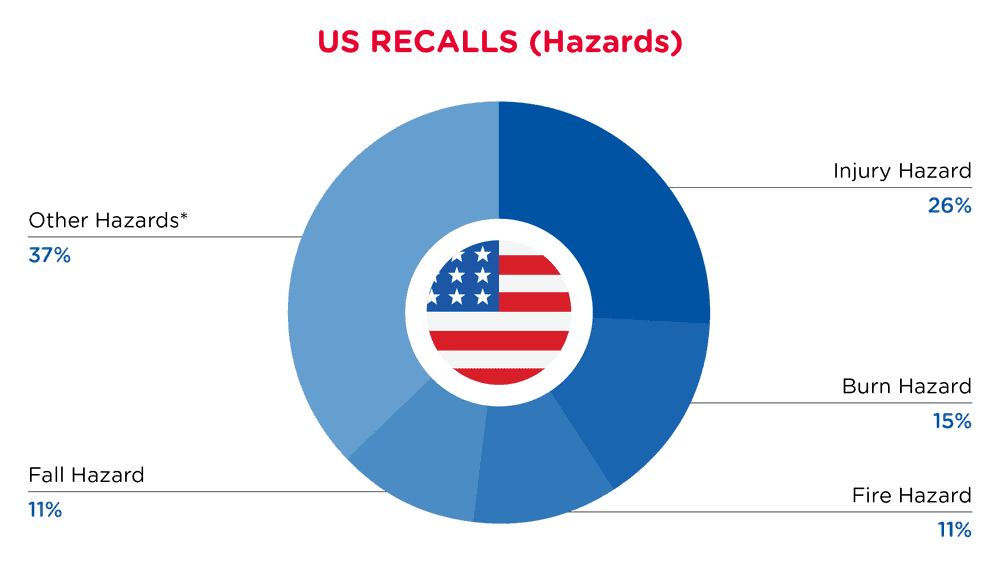
| Hazards | Frequency |
| Injury Hazard | 7 |
| Burn Hazard | 4 |
| Fire Hazard | 3 |
| Fall Hazard | 3 |
| Other Hazards* | 10 |
*Other Hazards include Crushing Hazard, Crash Hazard, Entanglement Hazard, Microbiological Hazard, Impact Hazard, Poisoning Hazard, Entrapment Hazard, Risk of Death, Suffocation Hazard, Choking Hazard with a frequency of less than 2.

| Product Categories | Frequency |
| Toys and Childcare Products | 5 |
| Fabric / Textile / Garment / Home Textile | 3 |
| Home Electrical Appliances | 3 |
| Furniture | 2 |
| Sporting Goods / Equipment | 2 |
| Protective Equipment | 2 |
| Outdoor Living Items | 1 |
| Electrical Appliances | 1 |
For a complete list click here
In Canada, when hazards are identified in consumer products, they will be recalled and published in the Recalls and Safety Alerts Database on the Health Canada website, which is updated daily. The Canada recalls from 01 November 2024 to 30 November 2024 are summarized below:
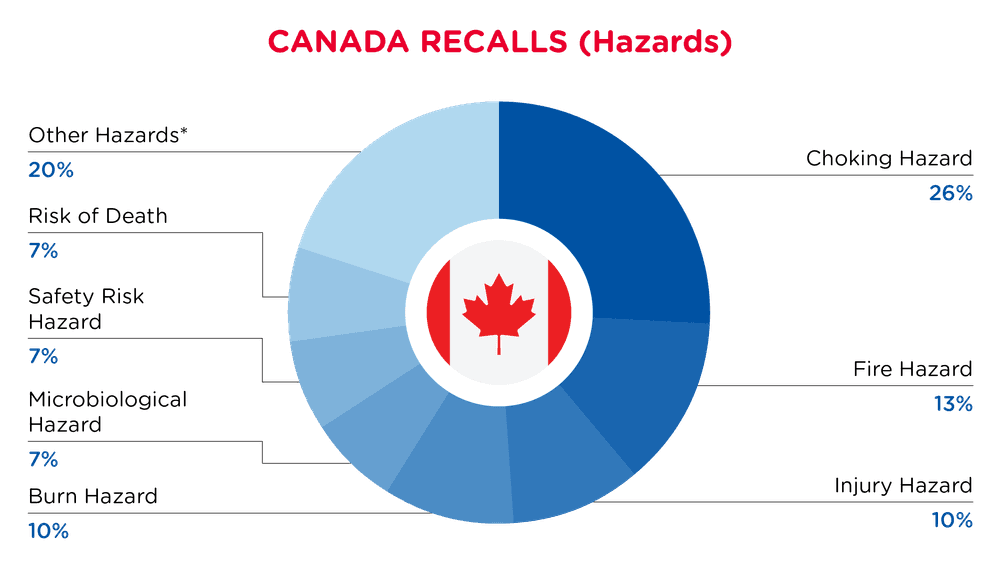
| Hazards | Frequency |
| Choking Hazard | 8 |
| Fire Hazard | 4 |
| Injury Hazard | 3 |
| Burn Hazard | 3 |
| Microbiological Hazard | 2 |
| Safety Risk Hazard | 2 |
| Risk of Death | 2 |
| Other Hazards* | 6 |
*Other Hazards include Lead Poisoning Hazard, Crushing Hazard, Tip-Over Hazard, Impact Hazard, Fall Hazard and Poisoning Hazard with a frequency of less than 2.

| Product Categories | Frequency |
| Toys and Childcare Products | 10 |
| Electrical Appliances | 3 |
| Home Electrical Appliances | 2 |
| Protective Equipment | 2 |
| Chemicals | 1 |
| Food Contact Material | 1 |
| Fabric / Textile / Garment / Home Textile | 1 |
| Bodycare / Cosmetics | 1 |
| Furniture | 1 |
| Household Items | 1 |
For a complete list click here
Europe News
The European Committee for Standardization (CEN) published updated Toy Safety Standard EN 71-3:2019+A2:2024.
The European Committee for Standardization (CEN) published the updated EN 71-3:2019+A2:2024, Safety of Toys – Part 3: Migration of Certain Elements standard on 4 December 2024.
This new standard will be given the status of national standard by June 2025 and conflicting national standards are to be withdrawn no later than this date. This standard is expected to become a harmonized standard under EU Toy Safety Directive 2009/48/EC after it is accepted by the European Commission and is published in the Official Journal of the European Union (EU).
Compared with the existing version, EN 71-3:2019+A1:2021, the main updates are shown as below.
| Related area | Changes in EN 71-3:2019+A2:2024 |
|---|---|
| Testing approach | Indicates the use of CEN/TS 17973:2023 “Safety of Toys – Categorization of slime type materials” for the categorization of products with slime-like properties Emphasizes the test portions must not be composed of more than one toy material unless the specimens cannot be physically separated Emphasizes the analysis of composite testing is not described and cannot be used without modification and may lead to deviating results when applied. The composite can be useful for raw materials checks or pre-tests of materials Requires an otherwise prominently displayed warning provided prior to purchase that the consumer does not have to search for in the general contents of the website |
| Migration procedure | Removes the de-waxing procedure from the products containing grease, oil, wax or similar materials as the de-waxing step was found to affect the reproducibility of the test results Allows the total migrated tin result to be used to presume the compliance of the organic tin requirement Allows the total migrated chromium result to be used to presume the compliance of both chromium (III) and chromium (VI) requirements |
In addition, it also introduced other EN 71 series standards for toys:
EN71-13: 2021+A2:2024, Safety of toys – Part 13: Olfactory board games, cosmetic kits and gustative games
EN71-18:2024, Safety of toys – Part 18: Phenol in aqueous (content) and polymeric (migration) toy materials
EN71-19:2024, Safety of toys – Part 19: Migration of bisphenol A from toy materials
Manufacturers and distributors should carefully review their toy product lines against the new requirements to ensure compliance by the effective date.
European Union Member States gave their agreement to a ban of bisphenol A (BPA) in food contact materials in June 2024. Now the European Parliament and the Council have given the greenlight to pass it into law.
On 19 December 2024, the European Union (EU) adopted a ban of bisphenol A (BPA) in food contact materials and articles. This regulation is a specific measure within the meaning of Article 5 of Regulation (EC) No 1935/2004 on materials and articles intended to come into contact with food. Bisphenol A is an endocrine disruptor due to its hormonal effects and was classified as a substance of very high concern (SVHC) in 2022 by the European Chemicals Agency.
Main points in the draft EU regulation are:
Current application of BPA:
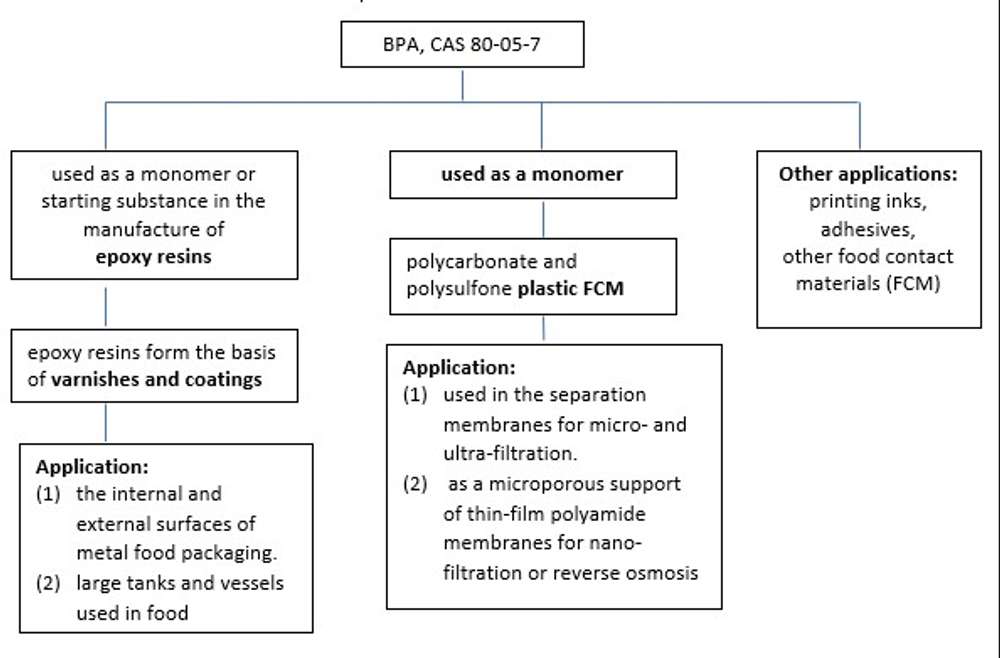
2. Prohibition of BPA:
| Item | Now | Before |
|---|---|---|
| Tolerable Daily Intake (TDI) | TDI of 2023: 0.2 ng/kg | TDI of 2015: 4 μg/kg |
| Requirement | BPA and its salts prohibited Specific Migration Level (SML) for the derogation: None Detected (ND) (Detection Limit (DL): 1μg/kg) | 0.05 mg/kg |
| (Restrictions and specifications | By way of derogation from BPA prohibition, BPA and its salts may be used in the manufacture of: epoxy resins to be applied on self-supporting food contact materials or articles with a capacity greater than 1000 liters use as a monomer or starting substance in the manufacture of polysulfone filtration membrane assemblies | Not to be used for the manufacture of polycarbonate infant feeding bottles Not to be used for the manufacture of polycarbonate drinking cups or bottles which, due to their spill proof characteristics, are intended for infants and young children |
3. Verification of compliance:
BPA residual: extraction method.
BPA migration: the rules and parameters are the same as EU 10/2011 on plastic materials and articles intended to come into contact with food.
4. Declaration of compliance:
Accompany the FCM at all stages of placing on the market, except during the retail stage.
Include an indication whether BPA has been used.
Transition period:
| Product types | Transition period |
|---|---|
| General articles | 18 months |
| Packaging with varnishes and coatings manufactured with BPA, specifically used to preserve fruit, vegetables and processed fish products | 36 months |
| Metal packaging that has external/ internal surfaces applied with BPA varnishes and coatings | 36 months |
| Single-use final FCM (including metal packaging) | Should be filled with food and sealed within 12 months from the end of the respective transitional periods, until exhaustion of stocks |
| Repeat-use components in professional food production equipment, such as confectionary molds, seals, pumps, flanges, gauges and sight glasses | 36 months |
| Repeat-use final food contact articles that have been first placed on the market by their manufacturers | In order to avoid large stocks, sales can continue for a maximum period of one year |
| Repeat-use final food contact articles used as professional food production equipment | Continue to use until falling into disuse |
Relationship with other regulations:
Repeal Regulation (EU) 2018/213 on the use of bisphenol A in varnishes and coatings The measures provided for in this Regulation supersede the measures laid down in Regulation (EU) 2018/213. It is therefore appropriate to repeal (EU) 2018/213.
2. Amending Regulation (EU) No 10/2011
By way of derogation from Article 5, BPA added.
In Table 1 of Annex I, the entries concerning substance No. 151 (BPA) and substance No. 154 (BPS) are deleted.
In Europe, when hazards are identified in non-food consumer products, the products will be recalled and published in the Safety Gate system, which is updated weekly. The European recalls from 01 November 2024 to 30 November 2024 are summarized below:
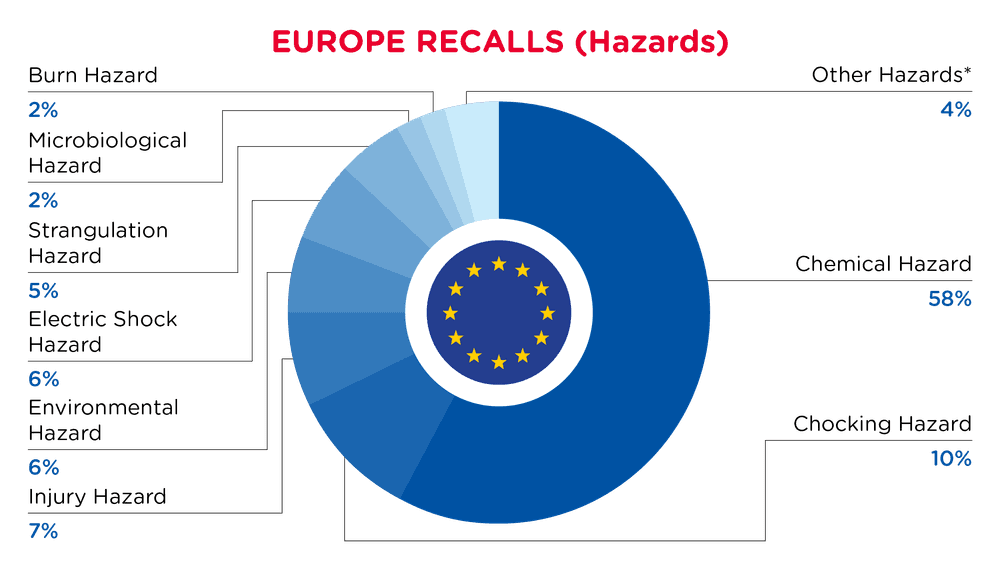
| Hazards | Frequency |
| Chemical Hazard | 217 |
| Choking Hazard | 39 |
| Injury Hazard | 27 |
| Environmental Hazard | 23 |
| Electric Shock Hazard | 22 |
| Strangulation Hazard | 20 |
| Microbiological Hazard | 6 |
| Burn Hazard | 6 |
| Other Hazards* | 16 |
*Other Hazards include Damage to Sight, Health Risk Hazard, Cut Hazard, Entrapment Hazard, Suffocation Hazard and Fire Hazard with a frequency of less than 4.

| Product Categories | Frequency |
| Bodycare / Cosmetics | 156 |
| Toys and Childcare Products | 70 |
| Electrical Appliances | 33 |
| Jewelry | 29 |
| Chemicals | 16 |
| Fabric / Textile / Garment / Home Textile | 10 |
| Other Categories* | 30 |
*Other Categories include Computer / Audio / Video / Other Electronics & Accessories, Sporting Goods / Equipment, Protective Equipment, Outdoor Living Items, Machinery, Furniture, Food Contact Material, Home Electrical Appliances, Accessories, Footwear, Car Accessories and Pet Items with a frequency of less than 6.
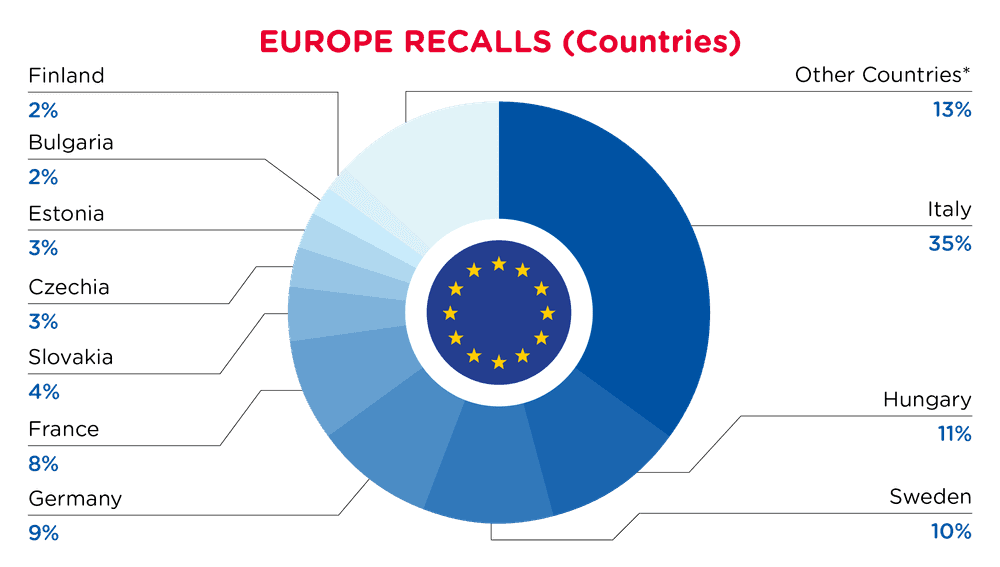
| Notifying Country | Frequency |
| Italy | 120 |
| Hungary | 38 |
| Sweden | 35 |
| Germany | 32 |
| France | 28 |
| Slovakia | 12 |
| Czechia | 10 |
| Estonia | 8 |
| Bulgaria | 8 |
| Finland | 8 |
| Other Countries* | 45 |
*Other Countries include Denmark, Croatia, Ireland, Spain, Romania, Luxembourg, Poland, Austria, Lithuania, Cyprus, Iceland and Latvia with a frequency of less than 8.
For a complete list click here
Asia News
An amendment to the Japan Specifications and Standards for Food and Food Additives, Etc. (outlined in Notice No. 370 of 1959) was issued on 5 November 2024. The amendment mainly addresses revisions of specifications and test methods for use of apparatus or for containers and packaging.
A partial amendment to the Specifications and Standards for Food and Food Additives, Etc. (Public Notice of the Ministry of Health and Welfare No. 370 of 1959) was issued on 5 November 2024. The Consumer Affairs Agency (CAA) of Japan notified the World Trade Organization (WTO) of the amendment on 12 November 2024. The 60-day comment period for the amendment ended on 26 October 2024.
Key Points:
1. Introduction of Positive List System:
A Positive List System was introduced earlier on 1 June 2020, to manage synthetic resins used in food containers and packaging. This system prohibits the use of materials unless explicitly allowed, ensuring only safe materials are used.
2. Regulation Updates Include:
Removal of obsolete test methods and standards, particularly for container strength and specific packaging materials.
Reorganization of regulations for better coherence and applicability.
Introduction of new testing methods to manage the migration of substances from packaging to food.
Specific changes in standards for synthetic resins and requirements for testing materials that unintentionally migrate into food.
3. Detailed Changes:
Introduction of total extractives tests and revisions to existing tests like the potassium permanganate consumption test and evaporative residue tests.
Revision of the standards for the residual solvent and Bisphenol-A (including phenol and p-tert-butylphenol) test solutions.
Adjustments to regulations for the use of glass containers for beverages and dairy products.
4. Implementation Timeline:
The amendments will be implemented in stages, starting from various dates in 2024 and 2025.
A transitional period of one year will be provided for compliance with the new regulations.
Specific materials and methods in use before the new regulations will continue to be allowed during a transitional period until 31 May 2027.
The updates, implementation dates and transitional periods should be reviewed to ensure compliance.
China News
In China, when hazards are identified in consumer products, they will be recalled and published in the SAMR Defective Product Administrative Centre, which is updated daily. The China recalls from 01 November 2024 to 30 November 2024 are summarized below:
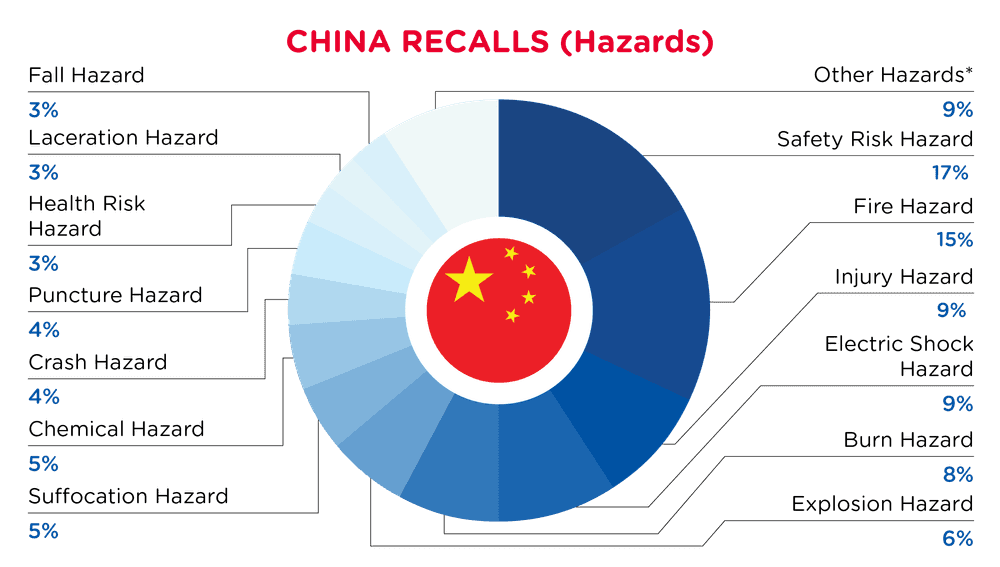
| Hazards | Frequency |
| Safety Risk Hazard | 46 |
| Fire Hazard | 40 |
| Injury Hazard | 25 |
| Electric Shock Hazard | 24 |
| Burn Hazard | 21 |
| Explosion Hazard | 16 |
| Suffocation Hazard | 14 |
| Chemical Hazard | 13 |
| Crash Hazard | 12 |
| Puncture Hazard | 10 |
| Health Risk Hazard | 9 |
| Laceration Hazard | 7 |
| Fall Hazard | 7 |
| Other Hazards* | 23 |
*Other Hazards include Swallowing Risk, Choking Hazard, Entanglement Hazard, Damage to Sight, Cut Hazard, Skin Irritation Risk and Risk of Death with a frequency of less than 7.

| Product Categories | Frequency |
| Toys and Childcare Products | 58 |
| Sporting Goods / Equipment | 34 |
| Fabric / Textile / Garment / Home Textile | 19 |
| Food Contact Material | 15 |
| Electrical Appliances | 13 |
| Stationery | 8 |
| Home Electrical Appliances | 8 |
| Tools and Hardware | 6 |
| Other Categories* | 8 |
*Other Categories include Furniture, Footwear, Chemicals, Computer / Audio / Video / Other Electronics & Accessories, Protective Equipment, Accessories and Household Items with a frequency of less than 2.

| Provinces | Frequency |
| Guangdong | 43 |
| Anhui | 38 |
| Tianjin | 25 |
| Hebei | 16 |
| Jiangsu | 12 |
| Hunan | 9 |
| Shanghai | 5 |
| Henan | 4 |
| Fujian | 4 |
| Other Provinces* | 13 |
*Other Provinces include Xinjiang, Inner Mongolia, Shaanxi, Yunnan, Shandong, and Beijing with a frequency of less than 3.
For a complete list click here
Australia/New Zealand News
In Australia, when hazards are identified in consumer products, they will be recalled and published in the Recalls and Safety Alerts Database on the Australian Competition & Consumer Commission website, which is updated daily. The Australia recalls from 01 November 2024 to 30 November 2024are summarized below:

| Hazards | Frequency |
| Injury Hazard | 23 |
| Risk of Death | 10 |
| Choking Hazard | 8 |
| Burn Hazard | 7 |
| Swallowing Risk | 7 |
| Fire Hazard | 5 |
| Drowning Hazard | 2 |
| Fall Hazard | 2 |
| Other Hazards* | 4 |
*Other Hazards include Puncture Hazard, Risk of Allergy, Skin Irritation Risk and Poisoning Hazard with a frequency of less than 2.

| Product Categories | Frequency |
| Electrical Appliances | 7 |
| Toys and Childcare Products | 3 |
| Sporting Goods / Equipment | 3 |
| Food Contact Material | 2 |
| Fabric / Textile / Garment / Home Textile | 2 |
| Other Categories* | 9 |
*Other Categories include Computer / Audio / Video / Other Electronics & Accessories, Pet Items, Car Accessories, Bodycare / Cosmetics, Home Electrical Appliances, Furniture, Protective Equipment, Accessories and Jewelry with a frequency of less than 2.
For a complete list click here
USA Federal News
The U.S. Consumer Product Safety Commission (CPSC or Commission) proposed to establish new performance and revised labeling requirements to address potentially deadly hazards associated with neck floats. The Commission also proposed to amend the CPSC's list of notice of requirements (NORs) to include neck floats.
The Consumer Product Safety Improvement Act of 2008 (CPSIA) mandates that ASTM F963 shall be a mandatory toy safety standard. This toy safety standard sets forth only minimal labeling requirements for aquatic toys such as neck floats. On 20 November 2024, the U.S. Consumer Product Safety Commission (CPSC or Commission) proposed to establish new performance and revised labeling requirements to address potentially deadly hazards associated with neck floats and proposed to amend the CPSC’s list of Notice of Requirements (NORs) to include these products.
The Notice of Proposed Rulemaking (NPR) proposes to add test requirements for conditioning, buoyancy, fastening systems, restraining systems, and neck openings and also to update marking, labeling and literature requirements. The additional requirements are more stringent than the existing requirements in 16 CFR 1250 Safety Standard Mandating ASTM F963 for Toys. The intent is to further reduce the risk of injury associated with neck floats and to provide the highest feasible level of safety for such products to address child drownings associated with neck floats.
The CPSC requests comments on all aspects of this rulemaking, noting the following topics:
Neck Float Definition
NPR Scope
Proposed Requirements To Address Slip-Through Due to Deflation
Proposed Requirements To Address Slip-Through Without Deflation
Proposed Requirements To Address Restraint System Failure
Proposed Requirements To Address Submergence Without Slip-Through
Proposed Test Methods
Proposed Warning Label and Instructional Material Requirements for Neck Floats
Initial Regulatory Flexibility Analysis
Feasibility
Comments are open until 21 January 2025.
Subscribe to our Regulatory Updates
Unsubscribe at any time. Read our privacy policy.